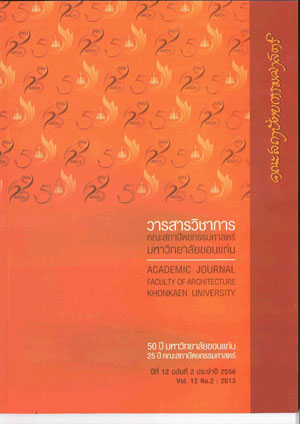การพัฒนาผลิตภัณฑ์เครื่องปั้นดินเผาชุมชนในท้องถิ่นภาคใต้ โดยใช้เตาเผาไฟสูง
คำสำคัญ:
เครื่องปั้นดินเผา, เตาเผาไฟสูง, ท้องถิ่นภาคใต้, Pottery, High Temperature Kiln, Southern Regions Communityบทคัดย่อ
งานวิจัยนี้มีวัตถุประสงค์เพื่อ (1) ศึกษาและพัฒนาวัตถุดิบที่มีอยู่ในท้องถิ่นภาคใต้ เพื่อนำ มาผลิตเครื่องเคลือบดินเผาและเตาเผาไฟสูงที่มีคุณภาพ (2) ศึกษาและพัฒนาผลิตภัณฑ์เครื่อง เคลือบดินเผาที่เหมาะสมกับท้องถิ่นภาคใต้ (3) ศึกษาและพัฒนาเตาเผาไฟสูงเพื่อสร้างต้นแบบ ที่เหมาะสมบนพื้นฐานความสามารถของท้องถิ่นภาคใต้
การวิจัยผลิตภัณฑ์เครื่องเคลือบดินเผา เพื่อเป็นประโยชน์ต่อการออกแบบและพัฒนา ผลิตภัณฑ์ในท้องถิ่นภาคใต้ เป็นการสร้างองค์ความรู้ให้กับชุมชน เลือกกลุ่มกรณีศึกษา ชุมชน บ้านมะยิงเป็นชุมชนที่มีการผลิตงานเครื่องปั้นดินเผามาเป็นเวลานานตั้งแต่อดีต เนื่องจากเป็น แหล่งที่มีศักยภาพพร้อมในการวิจัยและทดลองโดยใช้วัตถุดิบที่มีในท้องถิ่น สามารถพัฒนาอัตรา ผสมที่เหมาะสมของวัตถุดิบที่ใช้ในการพัฒนาเตาเผาไฟสูง และผลิตภัณฑ์เครื่องเคลือบดินเผาตาม อัตราส่วนผสมเนื้อดินที่ใช้ในการทำอิฐฉนวนสร้างเตาเผาไฟสูงจากทฤษฎีสามเหลี่ยม ด้านเท่า
ผลการวิจัยพบว่า (1) อัตราส่วนผสมของเนื้อดินที่ 9 มีส่วนผสม ดินท้องนาร้อยละ 80 ทราย ร้อยละ 12 แกลบ ร้อยละ 8 เป็นอัตราส่วนใช้ในทำอิฐขนาด 12×8×2นิ้ว (2) อัตราส่วนที่ 9 ของเนื้อ ดินปั้นผลิตภัณฑ์เครื่องเคลือบดินเผาไฟสูง มีส่วนผสมของเนื้อดินท้องนาร้อยละ 80 ทรายร้อยละ 16 ขี้เถ้าร้อยละ 4 เป็นส่วนผสม ที่สามารถขึ้นรูปได้ดี (3) อัตราส่วนผสมของนํ้าเคลือบที่ 6 มีส่วนผสมของ ขี้เถ้าไม้ยางพาราร้อยละ 30 แร่ฟันม้า (Feldspar) อำเภอท่าศาลา ร้อยละ 60 ดิน ท้องนาร้อยละ 10 ลักษณะคุณสมบัติที่ดี ซึ่งแสดงให้เห็นว่าแหล่งวัตถุดิบกลุ่มกรณีศึกษามีคุณภาพ สูงเหมาะสมในการพัฒนาผลิตภัณฑ์เครื่องเคลือบดินเผาไฟสูง และ (4) ผู้วิจัยมีแนวทางในการ ออกแบบรูปทรงและลวดลายที่เป็นเอกลักษณ์บ่งบอกถึงท้องถิ่นภาคใต้ เพื่อเพิ่มแนวทางในการ พัฒนาผลิตภัณฑ์ชุมชนอย่างยั่งยืน
ผลจากการสร้างต้นแบบของผลิตภัณฑ์ที่ได้ เป็นที่ยอมรับ ด้วยผลการประเมินความ พึงพอใจจากผู้เชี่ยวชาญผู้ผลิต และผู้บริโภคได้ค่าเฉลี่ยอยู่ในระดับที่มาก และงานวิจัยนี้บรรลุ วัตถุประสงค์ สามารถถ่ายทอดองค์ความรู้กระบวนในการพัฒนาอย่างเป็นระบบไปสู่ชุมชน ทำให้ เกิดการผลิตงานเครื่องเคลือบดินเผา ที่มีคุณภาพเป็นที่ต้องการผู้บริโภค
A Development of the Southern Region Thai Community Pottery High Temperature Kiln
Somjai Mameen
The purposes of this research study are as follow; (1) to study and develop materials found locally in Southern Thailand for producing a high temperature kiln and pottery, (2) to create knowledge of the Southern Regions community pottery’s need to design and kiln development to produce pottery groups in South Thailand, and (3) to study design trends and developments of high temperature kiln, and pottery, which are appropriate in the Southern parts of Thailand.
The case studies of product design and development in South Thailand was held at the “Ban Mayik” pottery community that has produced local pottery for a very long time. There was also an opportunity to study and experiment raw materials in the locality and to develop the appropriate raw material proportions to develop high temperature kiln, which was a tri-axial diagram.
This research results included; (1) the proportion number “9” of high temperature kiln clay were mixtures between 80 percents of local clay, 12 percent of sand, and 8 percent of chaff, with the appropriate for block size 12x8x2 inches, (2) the proportion number “9” of high temperature pottery clay was mixtures between 80 percents of local clay, 16 percents of sand, and 4 percents of chaff, (3) the proportion number “6” of glaze was mixtures between 30 percents of rubber tree ashes, 60 percents of “Ta Sala Feldspar”, and 10 percents of local clay. Those returned the fi ne quality and it indicated that the sources of material in the case study were high and appropriate for high temperature pottery, and (4) the researcher could create forms and patterns that refl ected Southern Thai identity and create trends permanently for local potter community development.
The prototypes were accepted by experts, producers, the community, and consumers. The average satisfaction was of a good class. The researcher could reach the objectives and relay the knowledge of systematic procedures to the local community, which created the high quality pottery that is required.
ดาวน์โหลด
รูปแบบการอ้างอิง
ฉบับ
ประเภทบทความ
สัญญาอนุญาต
ทัศนะและข้อคิดเห็นของบทความที่ปรากฏในวารสารฉบับนี้เป็นของผู้เขียนแต่ละท่าน ไม่ถือว่าเป็นทัศนะและความรับผิดชอบของกองบรรณาธิการ




